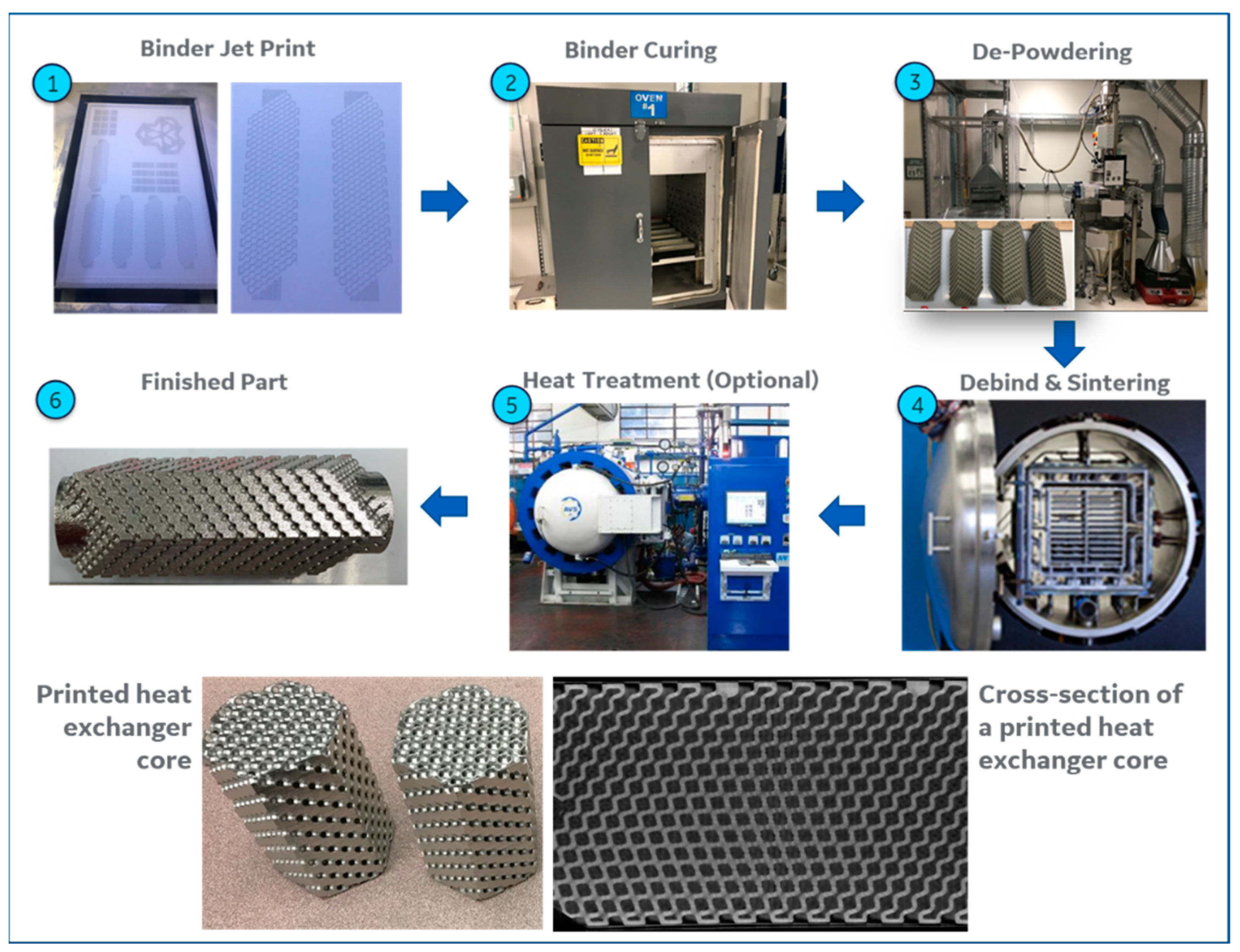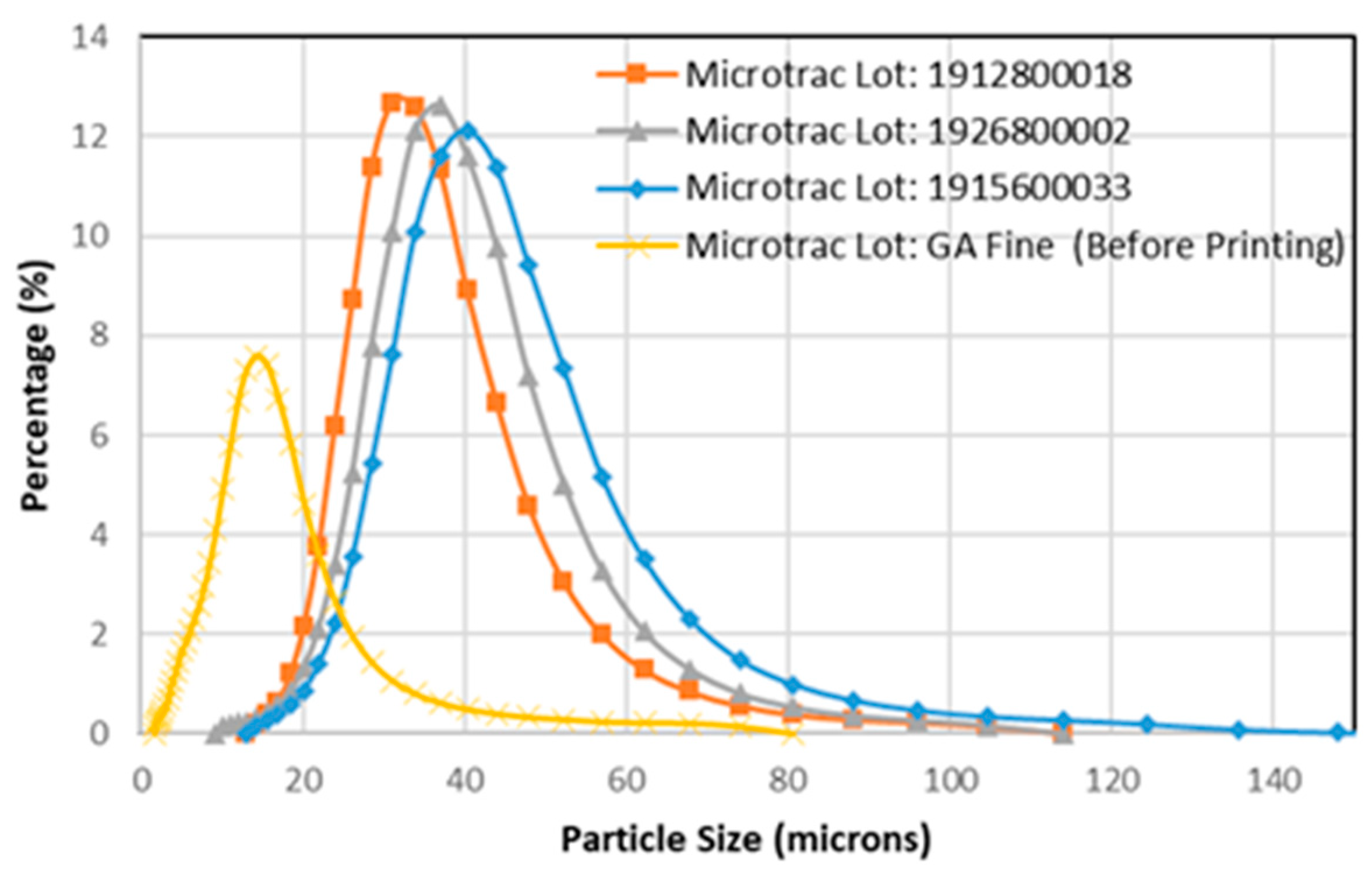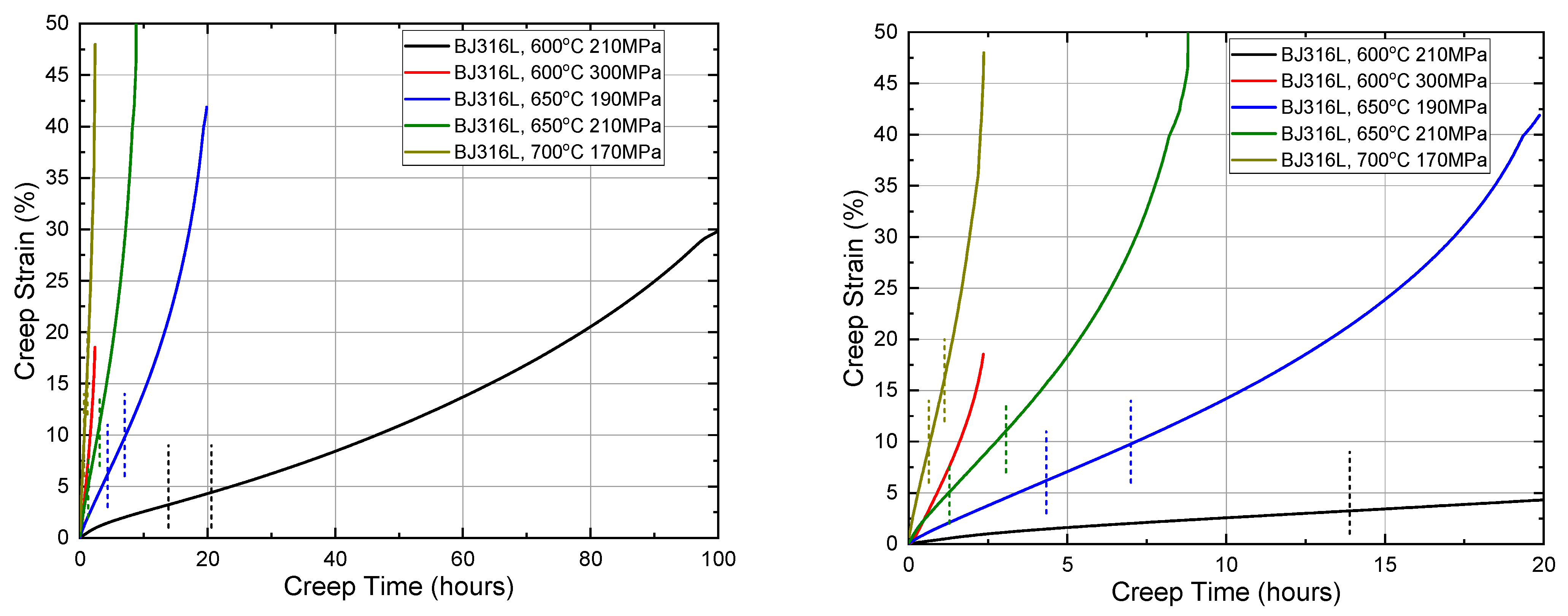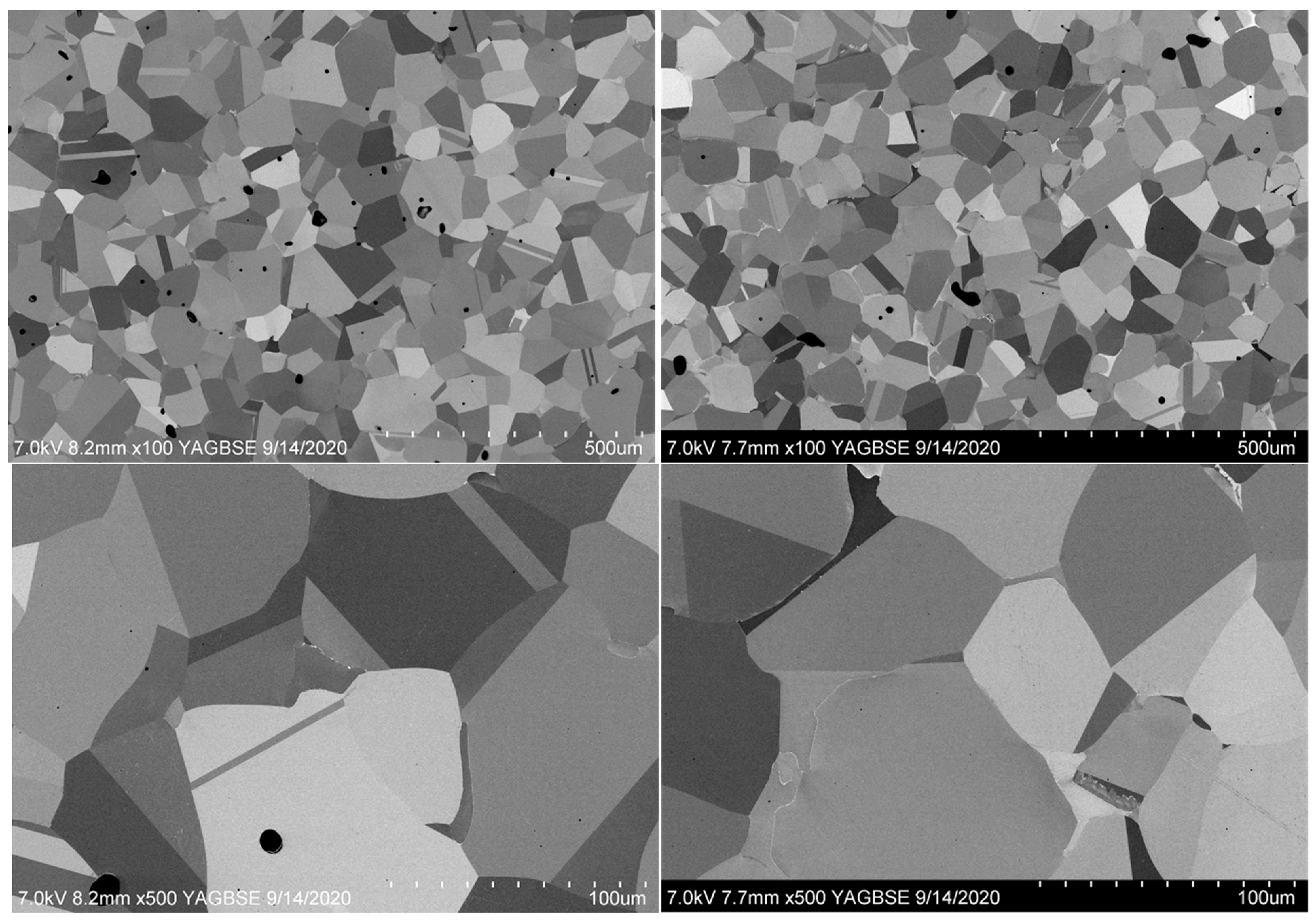Binder Jet Additive Manufacturing Process and Material Characterization for High Temperature Heat Exchangers Used in Concentrated Solar Power Applications
Abstract
:1. Introduction
1.1. Additive Manufacturing
1.2. Binder Jet Additive Manufacturing
2. Materials and Methods
2.1. Binder Jet AM Process
2.2. Powder and Materials Characterization
3. Results and Discussion
3.1. Powder Characterization
3.2. Materials Testing
3.2.1. Tensile Strength
3.2.2. Creep Testing
- powder size distribution
- powder composition
- build parameters
- binder material
- sintering profile
4. Conclusions
Author Contributions
Funding
Institutional Review Board Statement
Informed Consent Statement
Data Availability Statement
Acknowledgments
Conflicts of Interest
References
- Barua, A.; Gerstler, W.D.; Erno, D.J.; Wang, Y. Binderjet Additive Manufacturing for Complex Heat Exchanger Geometries. In Proceedings of the SolarPACES 2020, Online, 28 September 2020. [Google Scholar]
- Kwon, J.S.; Son, S.; Heo, J.Y.; Lee, J.I. Compact heat exchangers for supercritical CO2 power cycle application. Energy Convers. Manag. 2020, 209, 112666. [Google Scholar] [CrossRef]
- Li, W.; Yu, Z. Heat exchangers for cooling supercritical carbon dioxide and heat transfer enhancement: A review and assessment. Energy Rep. 2021, 7, 4085–4105. [Google Scholar] [CrossRef]
- Naveenan Thiagarajan, W.D. Novel Binderjet Additive HXs—A Pathway to 5¢/kWh CSP. In Proceedings of the Gen3 CSP Summit 2021, Virtual Event, 25–26 August 2021. [Google Scholar]
- Frazier, W.E. Metal additive manufacturing: A review. J. Mater. Eng. Perform. 2014, 23, 1917–1928. [Google Scholar] [CrossRef]
- Stornelli, G.; Faba, A.; Di Schino, A.; Folgarait, P.; Ridolfi, M.R.; Cardelli, E.; Montanari, R. Properties of Additively Manufactured Electric Steel Powder Cores with Increased Si Content. Materials 2021, 14, 1489. [Google Scholar] [CrossRef] [PubMed]
- Ziaee, M.; Crane, N.B. Binder Jetting: A Review of Process, Materials, and Methods. Addit. Manuf. 2019, 28, 781–801. [Google Scholar] [CrossRef]
- Patternmaker Sees Future in 3D. Mod. Cast. 2013, 103, 24–25.
- Almaghariz, E.S. Quantifying the role of part design complexity in using 3D sand printing for molds and cores. Int. J. Met. 2016, 10, 240–252. [Google Scholar] [CrossRef] [Green Version]
- Franchetti, M.A.; Kress, C. An economic analysis comparing the cost feasibility of replacing injection molding processes with emerging additive manufacturing techniques. Int. J. Adv. Manuf. Technol. 2017, 88, 2573–2579. [Google Scholar] [CrossRef]
- Kress, C. An Experimental and Theoretical Analysis of Additive Manufacturing and Injection Molding. Ph.D. Thesis, The University of Toledo, Toledo, OH, USA, 2015. [Google Scholar]
- Günther, D.A. Additive manufacturing of casting tools using powder-binder-jetting technology. In New Trends in 3D Printing; Intech: London, UK, 2016; pp. 53–85. [Google Scholar]
- Bai, Y.; Williams, C. An exploration of binder jetting of copper. Rapid Prototyp. J. 2015, 21, 177–185. [Google Scholar] [CrossRef] [Green Version]
- Lores, A.; Azurmendi, N.; Agote, I.; Zuza, E. A review on recent developments in binder jetting metal additive manufacturing: Materials and process characteristics. Powder Metall. 2019, 62, 267–296. [Google Scholar] [CrossRef]
- Byun, T.S.; Lach, T.G. Mechanical Properties of 304L and 316L Austenitic Stainless Steels after Thermal Aging for 1500 Hours; PNNL-25854; US Department of Energy/Office of Nuclear Energy: Richland, WA, USA, 2016. [Google Scholar]
- Sandvik. Material Datasheet. Sanmac 316/316L Bar. 2014. Available online: https://www.materials.sandvik/se/materialcenter/materialdatablad/bar-and-hollow-bar/bar/sanmac-316316l/?show=email-pdf (accessed on 17 July 2020).
- Tjong, S.C.; Zhu, S.M.; Ho, N.J.; Ku, J.S. Microstructural characteristics and creep rupture behavior of electron beam and laser welded AISI 316L stainless steel. J. Nucl. Mater. 1995, 227, 24–31. [Google Scholar] [CrossRef]
- Ryu, W.S.; Kim, D.W.; Kim, W.G.; Kuk, I.H. High temperature behaviors of type 316L (N) stainless steel. In Proceedings of the Transaction of the 15th International Conference on Structural Mechanics in Reactor Technology, Seoul, Korea, 15–20 August 1999. [Google Scholar]
- Rieth, M.; Falkenstein, A.; Graf, P.; Heger, S.; Jäntsch, U.; Klimiankou, M.; Materna-Morris, E.; Zimmermann, H. Creep of the Austenitic Steel AISI 316 L (N). Experiments and Models. (No. FZKA--7065); Forschungszentrum Karlsruhe GmbH Technik und Umwelt (Germany), Inst. fuer Materialforschung-Programm Kernfusion: Karlsruhe, Germany, 2004. [Google Scholar]
- Brinkman, C.R. Long-Term Creep and Creep-Rupture Behavior of Types 304 and 316 Stainless Steel, Type 316 Casting Material (CF8M), and 2 1/4 Cr-1 Mo Steel. Final Report (No. ORNL/TM-9896); Oak Ridge National Lab: Oak Ridge, TN, USA, 1986. [Google Scholar]
- Ravi, S.L.; Laha, K.; Mathew, M.D.; Vijayaraghavan, S.; Shanmugavel, M.; Rajan, K.K.; Jayakumar, T. A comparison of creep deformation and rupture behaviour of 316L (N) austenitic stainless steel in flowing sodium and in air. Procedia Eng. 2013, 55, 823–829. [Google Scholar] [CrossRef] [Green Version]
- Sasikala, G.; Mathew, M.; Bhanu, S.; Mannan, S. Assessment of Creep Behaviour of Austenitic Stainless Steel Welds; No. IAEA-TECDOC—933; International Atomic Energy Agency: Vienna, Austria, 1997. [Google Scholar]
- Sakthivel, T.; Vasudevan, M.; Laha, K.; Parameswaran, P.; Chandravathi, K.S.; Mathew, M.D.; Bhaduri, A.K. Comparison of creep rupture behaviour of type 316L (N) austenitic stainless steel joints welded by TIG and activated TIG welding processes. Mater. Sci. Eng. A 2011, 528, 6971–6980. [Google Scholar] [CrossRef]
- Sasikala, G.; Matthew, M.; Rao, B.S.; Mannan, S. Creep Deformation and Fracture Behavior of Types 316 and 316L(N) Stainless Steels and Their Weld Metals. Metall. Mater. Trans. A 2012, 31, 1175–1185. [Google Scholar] [CrossRef]
- Nassour, A.; Bose, W.W.; Spinelli, D. Creep properties of austenitic stainless-steel weld metals. J. Mater. Eng. Perform. 2001, 10, 693–698. [Google Scholar] [CrossRef]
- Mathew, M.; Latha, S.; Bhanu, S. An assessment of creep strength reduction factors for 316L(N) SS welds. Mater. Sci. Eng. A 2007, 456, 28–34. [Google Scholar] [CrossRef]
- Sakthivel, T.; Vasudevan, M.; Laha, K.; Parameswaran, P.; Chandravathi, K.S.; Mathew, M.D.; Bhaduri, A.K. Creep rupture strength of activated-TIG welded 316L (N) stainless steel. J. Nucl. Mater. 2011, 413, 36–40. [Google Scholar] [CrossRef]












| Lot Name | D10 (Microns) | D50 (Microns) | D90 (Microns) |
|---|---|---|---|
| GA Fine (Before Printing) | 5.2 | 12.6 | 22.6 |
| GA medium 1 | 22.6 | 31.7 | 46.7 |
| GA medium 2 | 24.1 | 35.1 | 51.1 |
| GA medium 3 | 26.4 | 38.6 | 57.5 |
| Lot Name | Time (s) |
|---|---|
| GA Fine (Before Printing) | no flow |
| GA medium 1 | 14.2 |
| GA medium 2 | 12.7 |
| GA medium 3 | 12.9 |
| BJAM-0.2% Yield (ksi) | 80% Yield Strength Target (of Cast Material) | ||||
| Temperature (°F) | Temperature (°C) | Average | 95% CI Upper Bound | 95% CI Lower Bound | |
| 75 | 23.9 | 31.0 | 33.7 | 28.4 | 27 |
| 400 | 204.4 | 23.9 | 24.7 | 23.2 | 19 |
| 800 | 426.7 | 19.6 | 26.1 | 13.0 | 13 |
| 1076 | 580 | 18.3 | 19.7 | 16.9 | 10 |
| BJAM-UTS (ksi) | 80% UTS Target (of Cast Material) | ||||
| Temperature (°F) | Temperature (°C) | Average | 95% CI Upper Bound | 95% CI Lower Bound | |
| 75 | 23.9 | 80.5 | 86.7 | 74.3 | 61 |
| 400 | 204.4 | 60.6 | 65.7 | 55.5 | 46 |
| 800 | 426.7 | 57.7 | 60.4 | 55.1 | 42 |
| 1076 | 580 | 50.3 | 54.0 | 46.6 | 40 |
| Temperature (°C) | Stress (MPa) | Rupture Time (Hours) |
|---|---|---|
| 700 | 170 | 2.4 |
| 650 | 210 | 8.8 |
| 650 | 190 | 19.9 |
| 600 | 300 | 2.4 |
| 600 | 210 | 106.2 |
Disclaimer/Publisher’s Note: The statements, opinions and data contained in all publications are solely those of the individual author(s) and contributor(s) and not of MDPI and/or the editor(s). MDPI and/or the editor(s) disclaim responsibility for any injury to people or property resulting from any ideas, methods, instructions or products referred to in the content. |
© 2023 by the authors. Licensee MDPI, Basel, Switzerland. This article is an open access article distributed under the terms and conditions of the Creative Commons Attribution (CC BY) license (https://creativecommons.org/licenses/by/4.0/).
Share and Cite
Gerstler, W.D.; Barua, A.; Huang, S.; Erno, D.J.; Wang, Y.; Ju, S.; Thiagarajan, N. Binder Jet Additive Manufacturing Process and Material Characterization for High Temperature Heat Exchangers Used in Concentrated Solar Power Applications. Metals 2023, 13, 617. https://doi.org/10.3390/met13030617
Gerstler WD, Barua A, Huang S, Erno DJ, Wang Y, Ju S, Thiagarajan N. Binder Jet Additive Manufacturing Process and Material Characterization for High Temperature Heat Exchangers Used in Concentrated Solar Power Applications. Metals. 2023; 13(3):617. https://doi.org/10.3390/met13030617
Chicago/Turabian StyleGerstler, William D., Ananda Barua, Shenyan Huang, Daniel J. Erno, Yongxiang Wang, Siyeong Ju, and Naveenan Thiagarajan. 2023. "Binder Jet Additive Manufacturing Process and Material Characterization for High Temperature Heat Exchangers Used in Concentrated Solar Power Applications" Metals 13, no. 3: 617. https://doi.org/10.3390/met13030617
APA StyleGerstler, W. D., Barua, A., Huang, S., Erno, D. J., Wang, Y., Ju, S., & Thiagarajan, N. (2023). Binder Jet Additive Manufacturing Process and Material Characterization for High Temperature Heat Exchangers Used in Concentrated Solar Power Applications. Metals, 13(3), 617. https://doi.org/10.3390/met13030617






